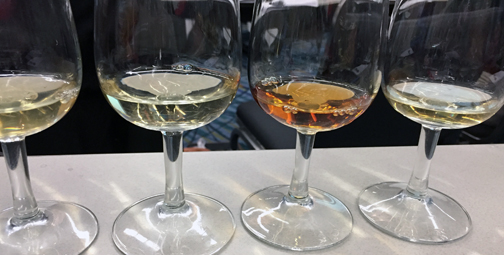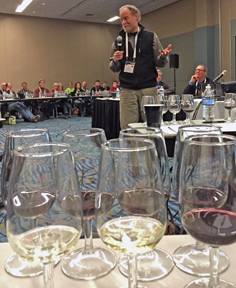On the second day of the Craft Beverages Unlimited trade show and conference, Kathy and I attended the afternoon forum on Post Modern Winemaking. The format of this session was different than sessions we attended in previous Wineries Unlimited shows. The room was arranged in a semi-circle of tables, with eight glasses at each setting. A microphone was between every three or four settings. The moderators, Dr. Bruce Zoecklein, Enology Professor Emeritus, Virginia Tech and Clark Smith, author of “Postmodern Winemaking” sat in the middle and directed the forum.
During this four-hour session, several topics were covered, wines were tasted and winemakers commented about the wines. Then there were questions from the attendees. Jim Law of Linden Vineyards and Winery began the forum with terroir winemaking. We then tasted and comment about several of his wines that showed unique characteristics based on terroir. Other topics that were discussed and wines tasted included:
• Reduction management
• Enological oxygen, O2 appetite
• Minerality
• Sulfite-free winemaking
The topic I was looking forward to was Clay Jar Wines. Clark Smith showed slides of photos of qvevris from the country Georgia. He talked about making wine in these qvevris buried underground. He asked me to say a few words about qvevris. I talked about preparing the qvevri for burial underground and the need to heat the qvevri to 160º F and coat the inside with beeswax that is heated to 220º F. I then spoke about making a grid of galvanized wire on the outside of the qvevri and adding a coat of lime based mortar to the outside of the qvevri. There was only one “clay jar wine” for tasting. This was a qvevri-made SINCE 1011 Rkatsiteli. SINCE 1011 is Alaverdi Monastery’s brand and refers to wines made at the monastery since the year 1011. The Rkatsiteli spent one and a half years in qvevri. The amber colored wine had an aroma and taste of dried fruit. The fruity finish had bold tannins.
Clark mentioned that the wine was not oxidized. Many conclude that qvevri white wines are oxidized based on the wine’s color. However spending so much time on the seeds, skins and stems will color many white wines a gold to amber. I did not notice any sherry-like or Jura-like aromas or flavors. The wine was complex and one needs to take in account the influence of seeds, skins and stems.

The 3rd wine from the left is the qvevri wine Since 1011 Rkatsiteli by Alaverdi Monastery in the country Georgia.
The forum set-up was interesting. The four-hour time frame was a bit long. I like the idea of talking about concepts and having wines to taste that blend with the concept. I wish we would have had more clay jar wines to taste. I would have liked to taste a white wine made in clay vessels that are not buried underground and compare to those buried underground. It would also be interesting to compare different wines that spend different amounts of time on their skins, seeds and stems.
Cheers,
Terry




Leave a Reply